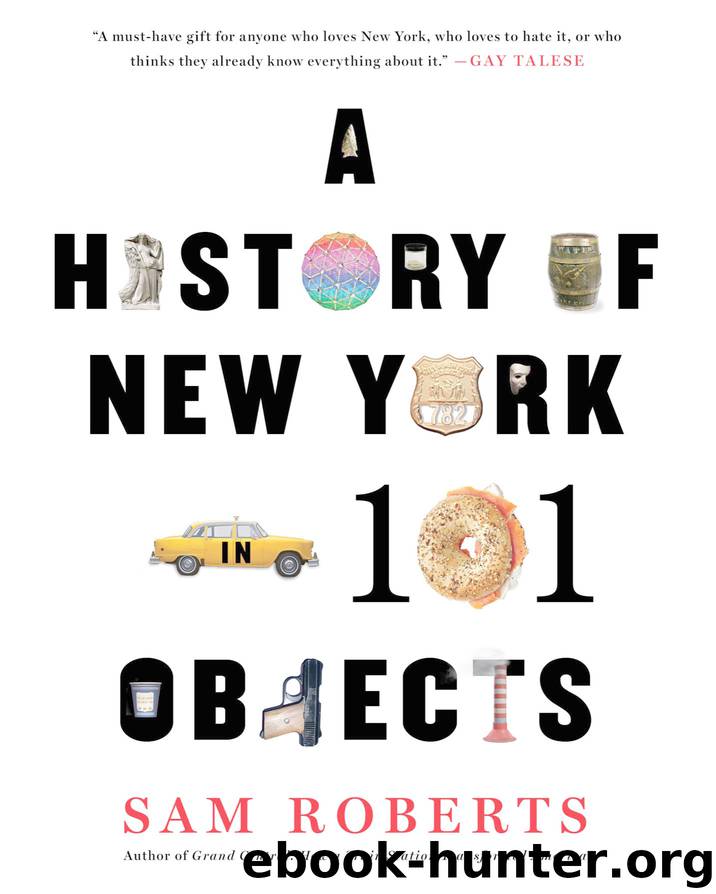A History of New York in 101 Objects by Sam Roberts

Author:Sam Roberts
Language: eng
Format: epub, mobi
Publisher: Simon & Schuster
● 54 ●
“To City” Sign
The “Outer” Boroughs
The city seen from the Queensboro Bridge,” F. Scott Fitzgerald wrote in The Great Gatsby, “is always the city seen for the first time, in its first wild promise of all the mystery and the beauty in the world.”
Talk about forgotten boroughs! Fitzgerald was facing Manhattan at the time, with his back literally and figuratively to Queens, one of the four stepchildren of the consolidation of Greater New York in 1898. Before then, “The City” was indeed Manhattan, coterminous with New York County and New York City (and distinguished from the City of Brooklyn). No wonder the so-called outer boroughs have suffered an inferiority complex ever since.
Well after 1898, certainly for half a century or more, signs on highways, subways, and elevated train lines in Brooklyn, Queens, and the Bronx (the only borough almost entirely on the mainland) pointed tauntingly “To City,” as if the outliers were merely out-of-towners. Sure, Manhattan generates most of the real estate tax revenue and city income tax and is home to Wall Street, Broadway theaters, corporate headquarters, and the most famous museums. And where else would the Sex and the City bus tour fete the show’s fans? But Manhattan ranks third in population (only the Bronx and Staten Island have fewer residents), although it’s the most densely populated and commuters nearly double its population on weekdays, and fifth in land area. Even Central Park is only the city’s fifth largest park. Manhattan doesn’t even have a professional baseball or football stadium.
Yet if New York is Oz, as the columnist Pete Hamill has written, Manhattan is undeniably its Emerald City. Each borough has its own cast, often anachronistic: the Bronx, a former symbol of urban blight; Queens, the blue-collar Archie Bunker bedroom borough (now the most variegated county in the nation); Brooklyn, the home to real New York attitude—“Leaving Brooklyn: Fuhgeddaboudit,” the official signs say—and the late, lamented Dodgers; and Staten Island, the bucolic borough that most closely resembles the suburbs but has, like the city’s suburbs, been growing more diverse.
Manhattan was always different, even before the Lower East Side became the East Village and Hamilton Heights gained a cachet that West Harlem did not. In a century, fewer than a half dozen of New York’s sixteen mayors have hailed from outside Manhattan. The disproportionate damage inflicted by snowstorms and hurricanes on the boroughs with less than sufficient mass transit worsened the real and perceived divide. The festering inferiority complex periodically boiled over into resentment against Manhattan’s hypocritical “limousine liberals,” who neglected the other half in this perennial tale of two cities. Symbolic of these iniquities to diehard New Yorkers who hailed from outside Manhattan were those “To City” signs.
Perhaps the most famous were two-foot-square DayGlo versions installed on Queens Boulevard in the 1960s by a contractor to detour traffic during reconstruction. The signs outlasted the repair project, a perennial thumb in the eye in a borough where nobody said they came from Queens, but typically identified with their local parish (much like Brooklynites would volunteer the name of their high school).
Download
A History of New York in 101 Objects by Sam Roberts.mobi
This site does not store any files on its server. We only index and link to content provided by other sites. Please contact the content providers to delete copyright contents if any and email us, we'll remove relevant links or contents immediately.
| African Americans | Civil War |
| Colonial Period | Immigrants |
| Revolution & Founding | State & Local |
Cat's cradle by Kurt Vonnegut(14763)
Pimp by Iceberg Slim(13781)
Underground: A Human History of the Worlds Beneath Our Feet by Will Hunt(11840)
4 3 2 1: A Novel by Paul Auster(11794)
The Radium Girls by Kate Moore(11622)
Wiseguy by Nicholas Pileggi(5320)
American History Stories, Volume III (Yesterday's Classics) by Pratt Mara L(5138)
Perfect Rhythm by Jae(5074)
The Fire Next Time by James Baldwin(5021)
Paper Towns by Green John(4800)
Pale Blue Dot by Carl Sagan(4620)
A Higher Loyalty: Truth, Lies, and Leadership by James Comey(4554)
The Mayflower and the Pilgrims' New World by Nathaniel Philbrick(4282)
The Doomsday Machine by Daniel Ellsberg(4248)
Killers of the Flower Moon: The Osage Murders and the Birth of the FBI by David Grann(4190)
Too Much and Not the Mood by Durga Chew-Bose(4096)
The Sympathizer by Viet Thanh Nguyen(4096)
The Borden Murders by Sarah Miller(4021)
Sticky Fingers by Joe Hagan(3913)
